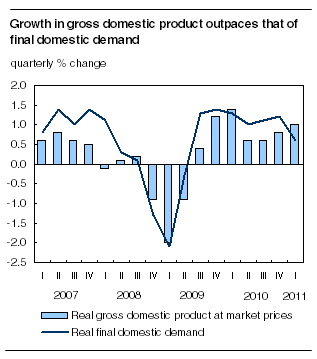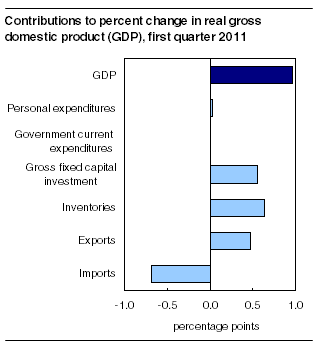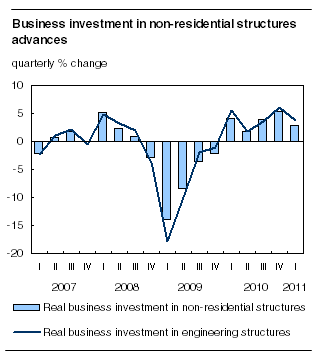Canadian economic accounts
Archived Content
Information identified as archived is provided for reference, research or recordkeeping purposes. It is not subject to the Government of Canada Web Standards and has not been altered or updated since it was archived. Please "contact us" to request a format other than those available.
Related subjects
-
[an error occurred while processing this directive]
Real gross domestic product (GDP) advanced 1.0% in the first quarter, following a 0.8% increase in the previous quarter. Final domestic demand rose 0.6%. On a monthly basis, real GDP by industry increased 0.3% in March.
Business investment in plant and equipment increased 3.2%, the fifth consecutive quarterly expansion. Investment in machinery and equipment rose 3.7% in the quarter. Business inventories accumulated, contributing to the growth in overall business investment.
Exports grew 1.6% in the first quarter, following a 2.1% increase in the fourth quarter of 2010. Imports rose 2.2%, after edging down 0.1% in the previous quarter.
All major industrial sectors, except for retail trade and arts, entertainment and recreation, increased their output in the first quarter. Goods production rose 1.8% while service-producing industries increased 0.7%. Manufacturing as well as mining and oil and gas extraction were the largest contributors to growth. Construction, transportation and wholesale trade also recorded notable increases.
Expressed at an annualized rate, real GDP in the first quarter grew 3.9%, after expanding 3.1% in the fourth quarter of 2010. By comparison, real GDP in the United States grew 1.8% in the first quarter.
Note to readers
Percentage changes for expenditure-based and industry-based statistics (such as personal expenditures, investment, exports, imports, and output) are calculated from volume measures that are adjusted for price variations. Percentage changes for income-based and flow-of-funds statistics (such as labour income, corporate profits, mortgage borrowing, and total funds raised) are calculated from nominal values; that is, they are not adjusted for price variations.
There are four ways of expressing growth rates for gross domestic product (GDP) and other time series found in this release.
1. Unless otherwise stated, the growth rates of all quarterly data in this release represent the percentage change in the series from one quarter to the next, such as from the fourth quarter of 2010 to the first quarter of 2011.
2. The quarterly growth can be expressed at an annual rate by using a compound growth formula, similar to the way in which a monthly interest rate can be expressed at an annual rate. Expressing growth at an annual rate facilitates comparisons to official GDP statistics from the United States. Both the quarterly growth rate and the annualized quarterly growth rate should be interpreted as an indication of the latest trend in GDP.
3. The year-over-year growth rate is the percentage change in GDP from a given quarter in one year to the same quarter one year later, such as from the first quarter of 2010 to the first quarter of 2011.
4. The growth rates of all monthly data in this release represent the percentage change in the series from one month to the next, such as from February to March 2011.


Business investment in plant and equipment increases
Business investment in plant and equipment rose 3.2% in the first quarter with increases in both non-residential structures (+2.8%) and machinery and equipment (+3.7%). Increases in plant and equipment investment have averaged 3.8% since the first quarter of 2010.

Business investment in engineering structures, which rose 3.7%, contributed the most to the increase in non-residential structures, while investment in buildings grew 0.6%.
Investment in industrial machinery, up 5.8%, contributed the most to the overall increase in machinery and equipment.
Business inventories build up
Business inventories increased $10.7 billion in the first quarter, after a small accumulation in the fourth quarter of 2010. Business inventory levels have been on an upward trend since the fourth quarter of 2009, in line with increased sales volumes.
Durable goods held by wholesalers and retailers accounted for most of the inventory accumulation in the first quarter.
Farm inventories increased after three consecutive quarterly reductions.
Imports up
Imports of goods and services increased 2.2% in the first quarter, after declining 0.1% in the previous quarter. Imports of automotive products, which rose 13%, contributed the most to the overall growth in goods imports. Imports of machinery and equipment, the second largest contributor to first quarter growth in imports of goods, have recorded seven consecutive quarterly increases.
Imports of services rose 2.0%, compared with a 2.5% growth in the previous quarter. First quarter increases were led by transportation services (+2.8%) and travel services (+2.1%).
Exports increase again
Exports of goods and services increased 1.6% during the quarter, following a 2.1% rise in the fourth quarter of 2010. Exports of goods were up 2.0% while services exports declined 1.0%. On average, exports have grown 1.8% since the third quarter of 2009.
Exports of energy (+8.9%) and automotive products (+6.5%) contributed the most to the gain in exports of goods. Meanwhile, exports of machinery and equipment declined 3.6%, following three quarters of growth.
The decline in exports of services was mainly due to declines in transportation services (-3.9%) and travel services (-3.0%).
Housing demand rises
Investment in housing rose 2.2% in the quarter. Expenditure on ownership transfer costs related to housing resale activity rose 8.0%, following a 17% gain in the previous quarter. Renovation activity increased 3.3% after three consecutive quarters of decline. In contrast, the value of new housing construction fell 1.1%.
Consumer spending remains unchanged
Consumer spending on goods and services was virtually unchanged in the first quarter, after increasing 1.1% in the fourth quarter of 2010. Consumers reduced their purchases of durable (-1.4%) and non-durable goods (-0.4%). However, consumers increased their purchases of services and semi-durable goods, each by 0.5%.
Expenditures on new and used motor vehicles declined 1.7%, after increasing 3.5% in the previous quarter.
Spending on furniture, furnishings and household equipment and maintenance declined 0.6%. This is the third decline in four quarters.
On the other hand, consumers increased their purchases of clothing and footwear by 1.7%, more than twice the pace of the previous quarter (+0.6%).
Incomes continue to rise
Nominal GDP continued to expand in the first quarter, growing 2.1%, a rate similar to that of the previous quarter (+2.2%).
Corporate profits increased 5.1%, as earnings for both financial and non-financial enterprises continued to grow.
Labour income grew 1.6%, up from the previous quarter's growth of 1.4%. Wages and salaries increased in both goods-producing (+2.3%) and services industries (+1.4%).
Personal disposable income rose 0.7%, a slower rate of growth than the 1.7% increase in the previous quarter. The decline in government transfers to persons in the quarter dampened disposable income growth.
The national saving rate was 6.6%, up from the fourth quarter 2010 rate of 5.5%. The income of all levels of government combined increased 1.5%, while government outlays were virtually unchanged. The national saving rate (6.6%) is now more than double the rate of 2.8% recorded in the third quarter of 2009. Increased saving in the corporate sector has been contributing to a higher saving rate.
Purchasing power expands
Canada's real gross domestic income, a measure of purchasing power, advanced 1.5% in the first quarter. Canada's terms of trade, which measure export prices relative to import prices, increased 1.6%.
The price of goods and services produced in Canada rose 1.1% in the first quarter. Higher prices for crude petroleum and petroleum and coal products were the main contributors to the overall price increase.
The price of final domestic demand rose 0.7%. Higher prices for motor fuels and lubricants and food and non-alcoholic beverages contributed the most to the increased price of final domestic demand.
Financial flows: Slowdown in financing activity
Total funds raised by domestic non-financial sectors amounted to $226 billion (seasonally adjusted at annual rates) in the first quarter, down from $281 billion in the fourth quarter of 2010. Financing activity was notably lower in both the non-financial corporations and government sectors.
Smaller deficits for government sectors dampened the demand for funds. Reduced borrowing by governments resulted from net redemptions of short-term paper, which were especially large at the federal government level. Bond issuance was the major source of financing in the government sector in the first quarter.
Funds raised by non-financial private corporations amounted to $73 billion in the first quarter, down almost 30% from a strong fourth quarter. A sharp reduction in bond issues accounted for this decline. New issues of corporate shares provided the bulk of external financing and supplemented increased internal sources of funds, particularly from undistributed earnings.
Household borrowing was also lower in the first quarter. Mortgages were up, partly reflecting housing resale and renovation activity. Consumer credit borrowing eased as consumer spending on durable goods softened.
The non-resident sector continued to be a net lender to the domestic economy in the first quarter, but at a slower pace. Foreign investment in Canadian securities continued to account for most of the inflows from abroad, equally split between Canadian bonds and equities.
Gross domestic product by industry, March 2011
Real gross domestic product increased 0.3% in March, following a 0.1% decline in February. Goods production increased 0.9% while the output of service industries was essentially unchanged. Manufacturing and, to a much lesser extent, construction and transportation were the main sources of growth. Wholesale trade and utilities also advanced. Retail trade as well as the finance and insurance sector recorded declines. Overall, mining and oil and gas extraction showed very little change for a third consecutive month.

Manufacturing grew 1.8% in March, after a 1.0% decrease in February. Durable goods manufacturing advanced 2.8%, while the production of non-durable goods increased 0.5%. Fabricated metal products, transportation equipment and machinery led the increases. Manufacturing of wood products, food, beverage and tobacco products declined.
Construction rose 0.7%, with all major components (residential and non-residential buildings, engineering and repair work) increasing.
Transportation rose 0.7%, primarily as a result of gains in truck and rail transportation.
Wholesale trade grew 0.4% in March. Wholesaling of petroleum products, motor vehicles and miscellaneous products (which include recyclable materials) led the way. Conversely, retail trade decreased by 1.0% as lower activity was recorded at clothing and accessories stores, food and beverage stores, and pharmacies.
The finance and insurance sector fell 0.9% in March. The decrease was mostly attributable to declines in the volume of personal loans, deposits and sales of mutual funds; the volume of trading on the stock exchanges also fell.
Overall, mining and oil and gas extraction edged up 0.1%. Support activities for mining, oil and gas extraction were up 9.7%. Metal ore mining also advanced in March. In contrast, oil and gas extraction declined, as a result of lower crude petroleum production.

Products, services and contact information
Detailed analysis and tables
The National economic accounts module, accessible from the Key resource module of our website, features an up-to-date portrait of national and provincial economies and their structure.
Additional tables and links to other releases from the national accounts can be found in the first quarter 2011 issue of Canadian Economic Accounts Quarterly Review, Vol. 10, no. 1 (13-010-X, free), now available from the Key resource module of our website under Publications. This publication will be updated on June 20, at the time of the release of the national balance sheet accounts. Revised estimates of the income and expenditure accounts covering the period from 2008 to 2010 have been released along with those for the first quarter of 2011. These estimates incorporate new and revised source data and updated estimates of seasonal patterns.
For a detailed analysis of the annual and quarterly revisions to gross domestic product and its components, consult the article "The 2008 to 2010 Revisions of the Income and Expenditure Accounts" in the publication Latest Developments in the Canadian Economic Accounts (13-605-X, free), available from the Key resource module of our website under Publications.
Gross domestic product by industry
Available on CANSIM: table 379-0027.
Definitions, data sources and methods: survey number 1301.
The March 2011 issue of Gross Domestic Product by Industry, Vol. 25, no. 3 (15-001-X, free), is now available from the Key resource module of our website under Publications.
Data on gross domestic product by industry for April will be released on June 30.
For more information, or to order data, contact the dissemination agent (toll-free 1-800-887-4623; 613-951-4623; iad-info-dci@statcan.gc.ca). To enquire about the concepts, methods or data quality of this release, contact Bernard Lefrançois (613-951-3622), Industry Accounts Division.
Income and expenditure accounts
Available on CANSIM: tables 026-0009, 380-0001 to 380-0017, 380-0019 to 380-0035, 380-0056, 380-0059 to 380-0062 and 382-0006.
Definitions, data sources and methods: survey numbers, including related surveys, 1901 and 2602.
The first quarter 2011 issues of National Income and Expenditure Accounts: Data Tables, Vol. 4, no. 1 (13-019-X, free), and Estimates of Labour Income: Data Tables, Vol. 4, no. 1 (13-021-X, free), are also now available from the Key resource module of our website under Publications.
For more information, or to enquire about the concepts, methods or data quality of this release, consult the Guide to the Income and Expenditure Accounts (13-017-X, free), or contact the information officer (613-951-3640; iead-info-dcrd@statcan.gc.ca), Income and Expenditure Accounts Division.
Financial flow accounts
Available on CANSIM: tables 378-0015 to 378-0048.
Definitions, data sources and methods: survey number 1804.
The first quarter 2011 issue of Financial Flow Accounts: Data Tables, Vol. 4, no. 1 (13-020-X, free), is also now available from the Key resource module of our website under Publications.
For more information, or to enquire about the concepts, methods or data quality of this release, contact the information officer (613-951-3640; iead-info-dcrd@statcan.gc.ca), Income and Expenditure Accounts Division.
- Date modified:
